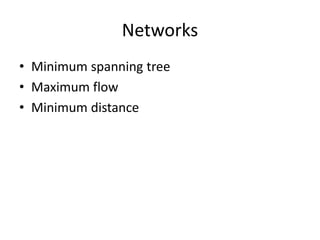
Networks ppt
- 1. Networks • Minimum spanning tree • Maximum flow • Minimum distance
- 3. Minimum Spanning tree : shortest way between ALL points A G F C H B D E 38 18 25 34 40 52 36 35 20 22 24 75 20 30
- 4. D A C G E B H 26 30 40 52 94 33 40 23 40 50 30 20 F50 26 Minimum Spanning tree : shortest way between ALL points
- 5. Networks A B C D E F G A - - 310 - 300 - 620 B - - 550 430 530 330 - C 310 550 - - 350 - - D - 430 - - - 210 390 E 300 530 350 - - 380 360 F - 330 - 210 380 - - G 620 - - 390 360 - - You can start at ANY node, but let’s choose A • Decide row/column (lets choose column) • If you choose a column, rule out the LINE for A • Find the shortest connection from A • Now Rule out the rest of row E • look at both columns for A and E for shortest connection • Rule out the rest of row C • Now we look at columns A, E, C for shortest connection • Rule out rest of row G • Include column G, find shortest from A, E, C, G Prim’s algorithm: Minimum Spanning Tree: AC, AE, EF, EG, FB, FD
- 6. Maximum flow: The maximum flow from the source, that reaches the endpoint (sink) 50 40 10 30 40 30 20 A B X C D A-B-X = 40 10 0 A-B-C-X = 100 0 30 A-C-X = 30 0 0 A-D-X = 20 10 0 Total = 100
- 7. The End